MARIANI’SVirtual
Gourmet
March
16, 2014
NEWSLETTER
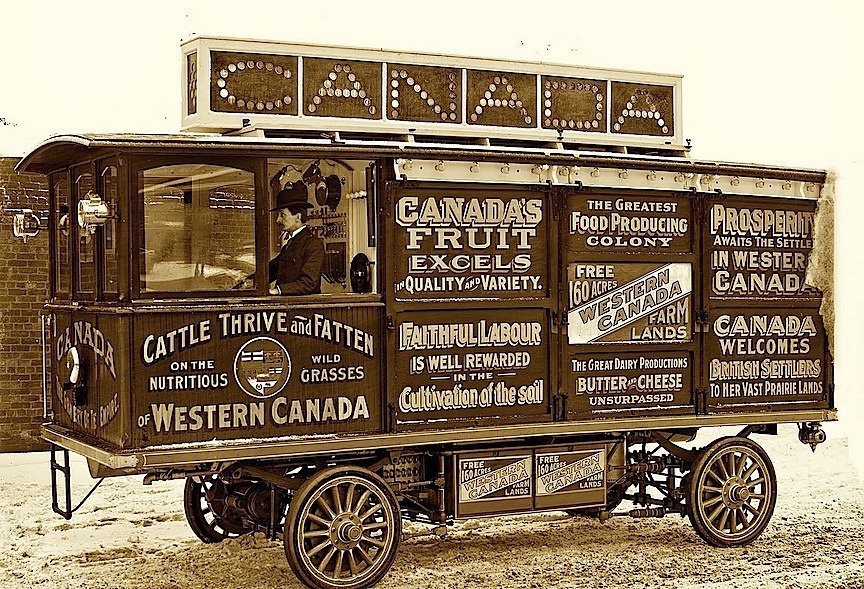
Canadian
advertising truck designed to attract settlers
IN THIS ISSUE
THE AIR UP THERE IN ST. MORITZ
By Brian Freedman
NEW YORK CORNER
Le Périgord
by John Mariani
NOTES FROM THE WINE CELLAR
IRISH WHISKEY
By John Mariani
❖❖❖
THE AIR UP THERE IN ST. MORITZ
By Brian Freedman
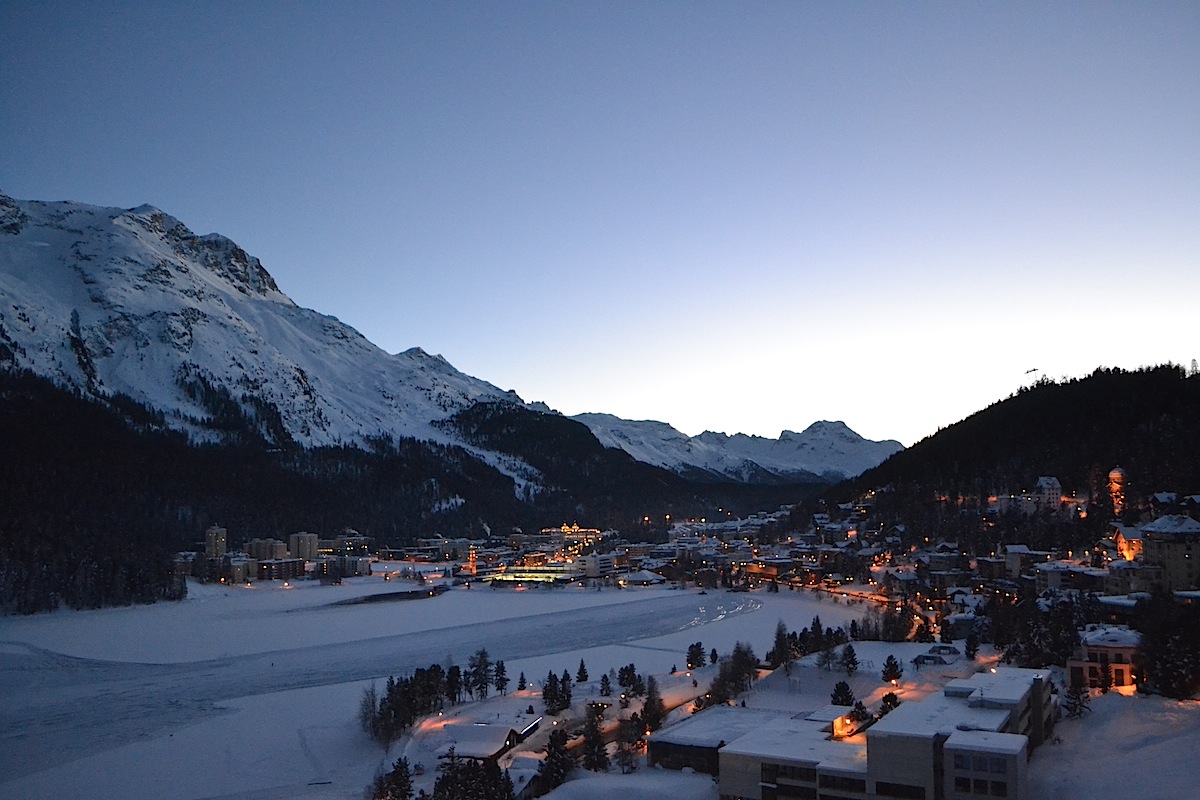
Lake St. Moritz
Photo by Brian Freedman
I’m
not the sort of guy who feels like James Bond all
that often. I prefer my martinis with gin; my
ability to charm the precious few femme fatales I
encounter on my travels is limited at best; I’m a
lousy shot with a handgun, and have never held a
Walther PPK. But, by the end of my first afternoon
at the magisterial Badrutt’s
Palace Hotel in St. Moritz, Switzerland, I
started to feel the first glimmers of my inner
007.
It all began with the
journey to this jewel of a resort town in the
Engadine Alps. The two-and-a-half-hour train ride from Zurich Kloten Airport
to St. Moritz--with very easy changes along the
way--includes a stretch that is a UNESCO World
Heritage Site: the Rhaetian Railway in the
Albula/Bernina Landscapes, its sight-seeing cars plummeting valleys and shimmying up the
sides of the mountains as it wends its way through
long tunnels and over vertiginous bridges and
viaducts.
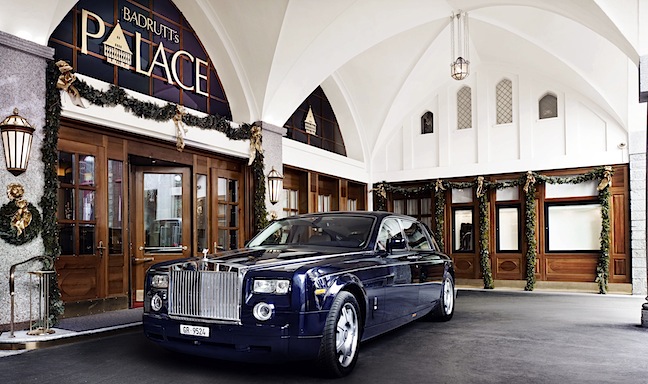 The week before we
arrived, in mid-January, the region had been favored
with nearly three feet of snow, and with the
frosty-tipped evergreens all regal and upright and
the snow-capped mountains in the distance, and the
locals twirling on their ice skates on the frozen
surface outside the town of Samedan, the trip gave
the distinct impression of having been transported
into a huge snow globe.
The week before we
arrived, in mid-January, the region had been favored
with nearly three feet of snow, and with the
frosty-tipped evergreens all regal and upright and
the snow-capped mountains in the distance, and the
locals twirling on their ice skates on the frozen
surface outside the town of Samedan, the trip gave
the distinct impression of having been transported
into a huge snow globe.
I was journeying to St.
Moritz to visit one of the most storied hotels in
Europe, the stunning Badrutt’s Palace, built by the
visionary Caspar Badrutt in 1896. It’s a five-star
hotel in official ranking only; I’m sure if it were
possible to award it seven stars, or nine, or 14, it
would earn them with ease. Not only is it a
physically stunning structure, but the feeling of
intimacy proffered by the exceptional staff makes it
truly extraordinary, even among the other five-star
resorts in St. Moritz.
Indeed, Badrutt’s Palace’s
concept of hospitality began as soon as I stepped
off the platform in the train station, greeted by a
driver and ushered to a waiting vintage Rolls Royce
for the short drive to the hotel.
“On Her Majesty’s Secret
Service” crossed my mind.
The
hotel is centrally located on the Via Serlas, a
shopping street that could rival many in the
world--Prada, Chanel, and an Omega watch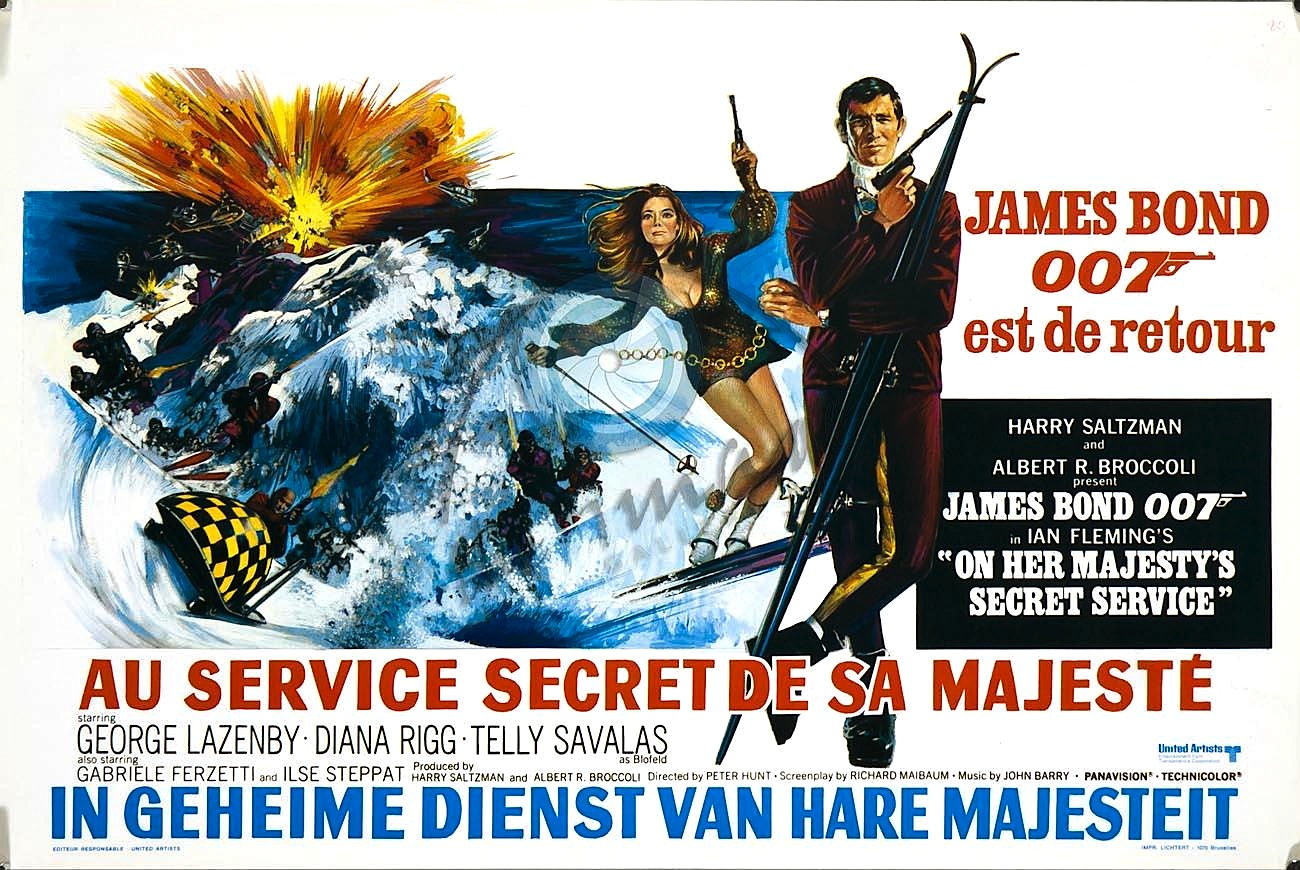 boutique
offering Bollinger Champagne or Beluga Vodka to
passersby in order to entice them to stop by and
pick up a watch or two. Badrutt’s boasts 157
rooms, including suites subdued and sprawling, with
public spaces said to be among the top
see-and-be-seen destinations among the old and new
money that descends upon St. Moritz each season.
However, I was there just after the Russian New Year
and Christmas, a slow period in St. Moritz.
boutique
offering Bollinger Champagne or Beluga Vodka to
passersby in order to entice them to stop by and
pick up a watch or two. Badrutt’s boasts 157
rooms, including suites subdued and sprawling, with
public spaces said to be among the top
see-and-be-seen destinations among the old and new
money that descends upon St. Moritz each season.
However, I was there just after the Russian New Year
and Christmas, a slow period in St. Moritz.
The advantage of this
relative quietude is that the public spaces often
felt like our own to take full advantage of.
And indeed, the vast spaces manage to exist at
two seemingly opposite poles at the same times: they
are breathtakingly grand, with intricate wood and
plaster work, towering ceilings, and mirrors of a
size and level of detail that they wouldn’t look at
all out of place in Versailles or a Habsburg castle;
at the same time, these same spaces remain
charmingly intimate. Historically, the
Palace’s guests weren’t always week-trippers as is
more often the case in our era. Generations ago,
before trains and planes made the trek to St. Moritz
as easy as it is today, families would spend a month
or more here and came loaded for it with steamer
trunks of clothing and even their own furniture, the
better to feel more at home. Over the years,
families simply left their armoires and side tables
and book-cases at the Palace, and many of these
handworked, inlaid, or otherwise magnificently
detailed objet
d’art still line the hallways like living
examples of the Palace’s history.
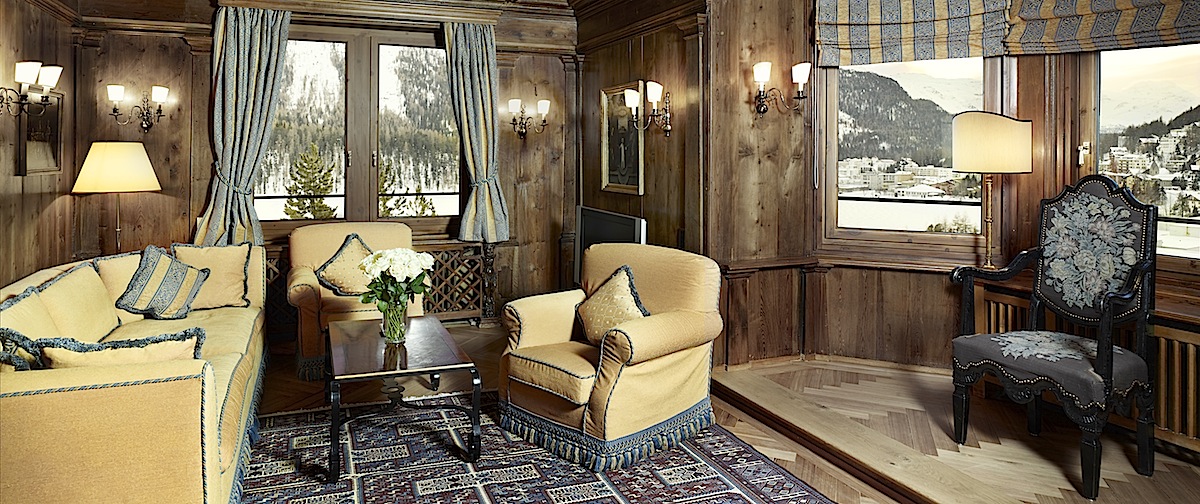 Unlike most of the world’s
grandest hotels, Badrutt’s Palace is still owned by
a single namesake family (though they recently
designated highly respected managing director Hans
Wiedemann to take over for them when they are no
longer able). So, for all the grandeur
of the place, it is also deeply personal, with a
real sense of soul and an attention to detail that
is little short of stunning. Not only is everything
cleaned and dusted and arranged to within a
nanometer of its perfect state, there is even a
fellow with a kind of rake that straightens the
fringes of the rugs throughout, lest they
inadvertently fall askew and throw off the geometry
of the impeccable space.
Unlike most of the world’s
grandest hotels, Badrutt’s Palace is still owned by
a single namesake family (though they recently
designated highly respected managing director Hans
Wiedemann to take over for them when they are no
longer able). So, for all the grandeur
of the place, it is also deeply personal, with a
real sense of soul and an attention to detail that
is little short of stunning. Not only is everything
cleaned and dusted and arranged to within a
nanometer of its perfect state, there is even a
fellow with a kind of rake that straightens the
fringes of the rugs throughout, lest they
inadvertently fall askew and throw off the geometry
of the impeccable space.
The rooms range from more modern
to classically styled. The Hitchcock Suite (above), for
example, is a multi-room ramble with plenty of
well-loved wood detailing and an understated
grandeur that only the burnishing years of history
can provide. Legend has it that Alfred
Hitchcock was first inspired to write his film “The
Birds” while staying here, watching birds swooping
past his windows (although the film was also loosely
based on a short story by Daphne du Maurier).
Accommodations run from
several hundred dollars a night all the way to more
than $20,000, a rate ostensibly reserved for Russian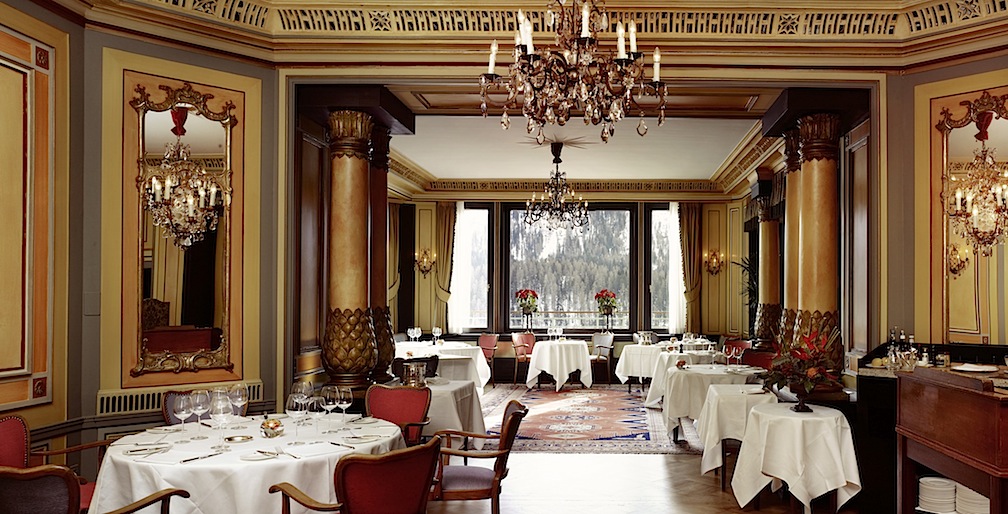 oligarchs
and movie stars. My room was a more restrained
double, and a fabulous example of what Badrutt’s
Palace does so well: make guests feel at home,
ensconced in deep comfort, and at the same time
somewhere very special. The room had tall
windows and a little balcony, etched with a brass
map of the view and the names of the mountains out
across the expanse. The bed was exceptionally
comfortable and the bathroom was a swath of marble.
oligarchs
and movie stars. My room was a more restrained
double, and a fabulous example of what Badrutt’s
Palace does so well: make guests feel at home,
ensconced in deep comfort, and at the same time
somewhere very special. The room had tall
windows and a little balcony, etched with a brass
map of the view and the names of the mountains out
across the expanse. The bed was exceptionally
comfortable and the bathroom was a swath of marble.
Our
first meal, a lunch, was taken in the quietly
elegant serenity of Le Relais (right), one of six restaurants
here. The room itself is tastefully designed
in a Belle Epoque style, with draped white
tablecloths and delicate stemware, all within view
of Lake St. Moritz and the mountains beyond. The
food is appropriately luxurious, too: an order of delicious Pojarski with shaved black
truffles and a foie gras crème was a perfect
welcome to the property, as was a bottle of brisk
Chablis, which itself seemed to be a liquid
embodiment of the crisp, fresh air just outside the
windows.
Truffles, in fact, would be
a recurring theme throughout our stay in St. Moritz.
For example, at the excellent Pizzeria Heuboden in
the charmingly rustic Chesa Veglia--“old farmhouse” (below)--just up
the hill from the Palace, the evening was
highlighted by the Dama Bianca pizza, a wood-oven
beauty with buffalo mozzarella, Taleggio, and
Parmesan, crowned with black truffles. Pizzeria
Heuboden boasts a wide-ranging menu, and the other
pizzas and pastas are equally enticing.
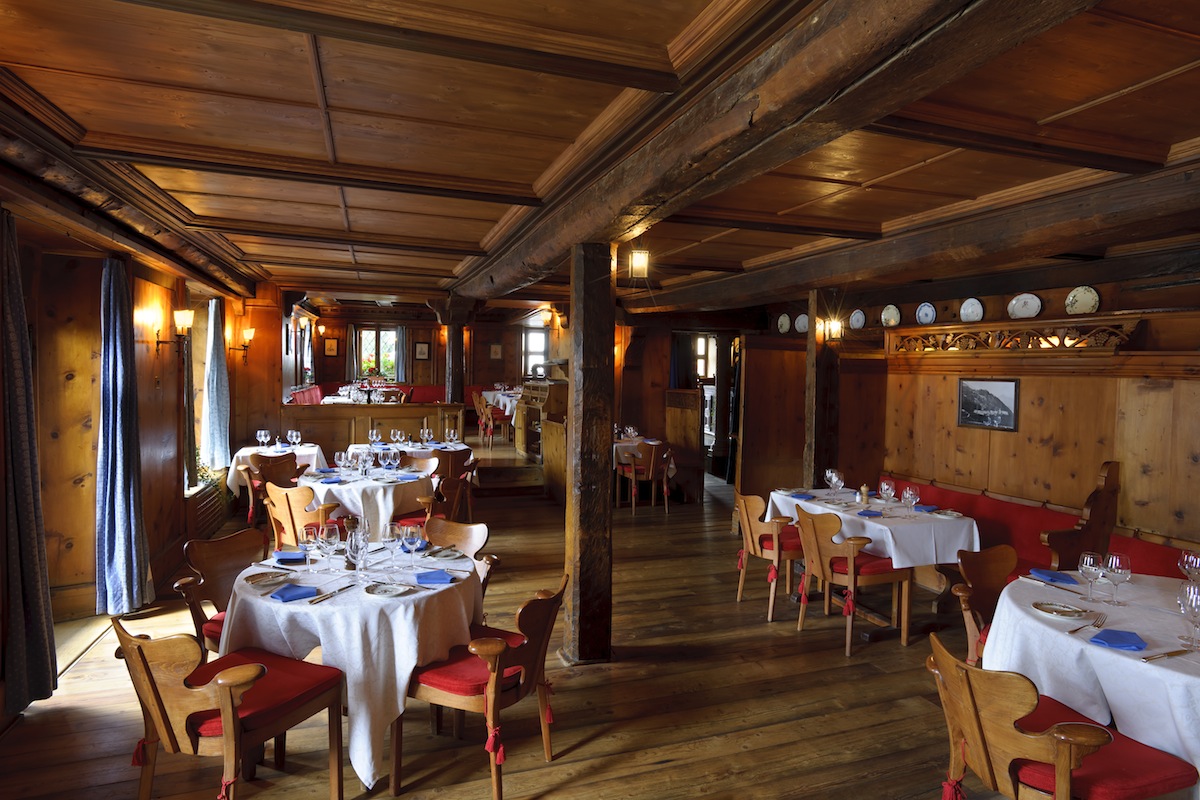 Even more
truffles greeted us at Mathi’s, a restaurant atop
the ski runs at Corviglia and Piz Nair, where I
skied with an excellent instructor, Jean-Pierre
Carnal, from Ski School St. Moritz, located in
Badrutt’s. The restaurant, with a stunning
view of the skiers and snowboarders below, is
exactly what I’ve always wished ski-mountain
restaurants would be on this side of the ocean, but
so rarely are. Instead of bread, we started
off our meal at Mathi’s with another black truffle
pizza. But this is more than a refueling stop: it
features impeccably poached salmon, well-roasted
beef, and more.
Even more
truffles greeted us at Mathi’s, a restaurant atop
the ski runs at Corviglia and Piz Nair, where I
skied with an excellent instructor, Jean-Pierre
Carnal, from Ski School St. Moritz, located in
Badrutt’s. The restaurant, with a stunning
view of the skiers and snowboarders below, is
exactly what I’ve always wished ski-mountain
restaurants would be on this side of the ocean, but
so rarely are. Instead of bread, we started
off our meal at Mathi’s with another black truffle
pizza. But this is more than a refueling stop: it
features impeccably poached salmon, well-roasted
beef, and more.
If you’ve overdosed on
truffles, Badrutt’s is also home to an outpost of
Nobu, which, while possessing somewhat less-focused
flavors and textures than I would have expected from
this international chain of Japanese restaurants,
was still a nice break from the hearty luxury of so
much else we’d been eating. So, too, was La Diala,
the casual restaurant at the fabulous wellness
center at Badrutt’s Palace, where I reveled in a
delicious club sandwich and my companions enjoyed
pastas, salads, and other dishes. Of particular note
was the Kalbfleischscheibe
mit Pilzsauce und Rösti, tender sliced
veal anointed with a mushroom sauce and accompanied
by the famous buttery, crispy roesti potato pancake
that visitors to this part of Switzerland invariably
come home talking about.
But it’s luxury that
Badrutt’s Palace is most well known for, and the
level provided here is not something to be passed
up. 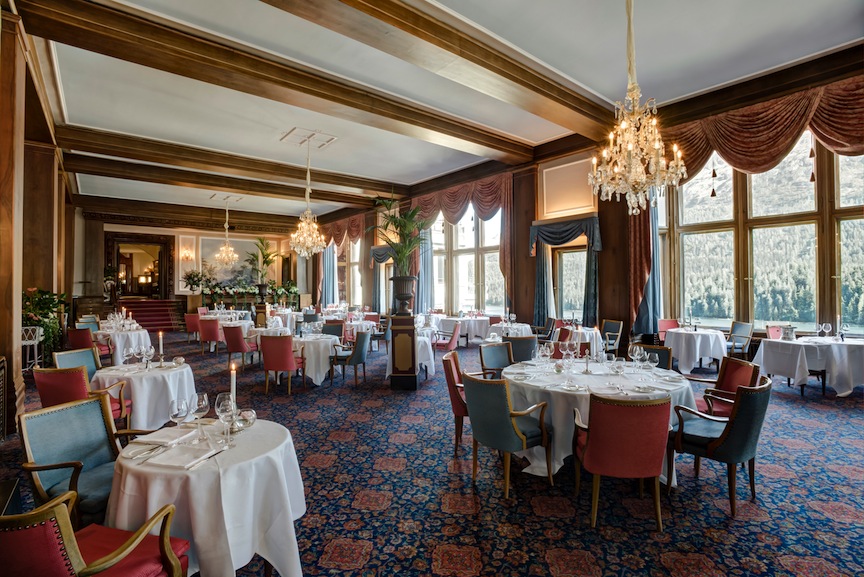 Dinner
at Le Restaurant (right), with
its tuxedo-clad waiters and gueridon service and a
pastry department as adept as any in the world, is a
perfect opportunity to enjoy the mind-boggling
selection of legendary wines from its cellar. In the
mood for a vertical of Haut-Brion? Perhaps a magnum
of DRC La Tâche? No problem at all. Order to
your bank account’s content; they have plenty.
Dinner
at Le Restaurant (right), with
its tuxedo-clad waiters and gueridon service and a
pastry department as adept as any in the world, is a
perfect opportunity to enjoy the mind-boggling
selection of legendary wines from its cellar. In the
mood for a vertical of Haut-Brion? Perhaps a magnum
of DRC La Tâche? No problem at all. Order to
your bank account’s content; they have plenty.
Breakfast, included with
the room price, is also taken in this same sweeping
space, enjoyed to the wonderfully soothing
accompaniment of a harpist. Why, I found myself
wondering after that first morning of pastries,
yogurt, eggs and more, did I not have
a harpist every morning in my house in suburban
Philadelphia?
It’s
tempting simply to set up camp in Badrutt’s Palace
and not leave. Plan a massage or other spa treatment
one morning; my massage, by the phenomenal Marinella
Negri, cured the nagging neck pain I’d been
suffering through for a full month. Spend the
afternoon in the swimming pool or outdoor hot tub or
one of the many saunas and steam rooms, then enjoy a
cocktail in the elegant Renaissance Bar or dance the
night away in the King’s Club disco and bar, all
within the Palace’s domain.
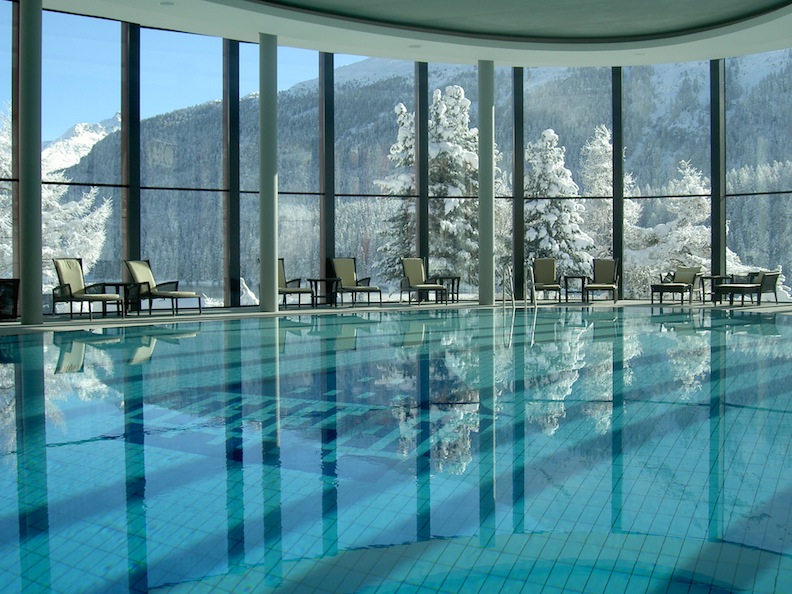 But the town itself is
also worth exploring. For lovers of wrist watches,
St. Moritz is like a waking dream, with familiar
brands like Rolex and TAG-Heuer offered alongside
less-familiar yet equally lust-worthy pieces by
Greubel Forsey, Franck Muller, and Blancpain, among
others. You might consider taking a horse-drawn
carriage ride, which Badrutt’s can arrange. Ours
included blankets to keep us warm, and a thermos of
gluhwein to keep us even warmer.
But the town itself is
also worth exploring. For lovers of wrist watches,
St. Moritz is like a waking dream, with familiar
brands like Rolex and TAG-Heuer offered alongside
less-familiar yet equally lust-worthy pieces by
Greubel Forsey, Franck Muller, and Blancpain, among
others. You might consider taking a horse-drawn
carriage ride, which Badrutt’s can arrange. Ours
included blankets to keep us warm, and a thermos of
gluhwein to keep us even warmer. 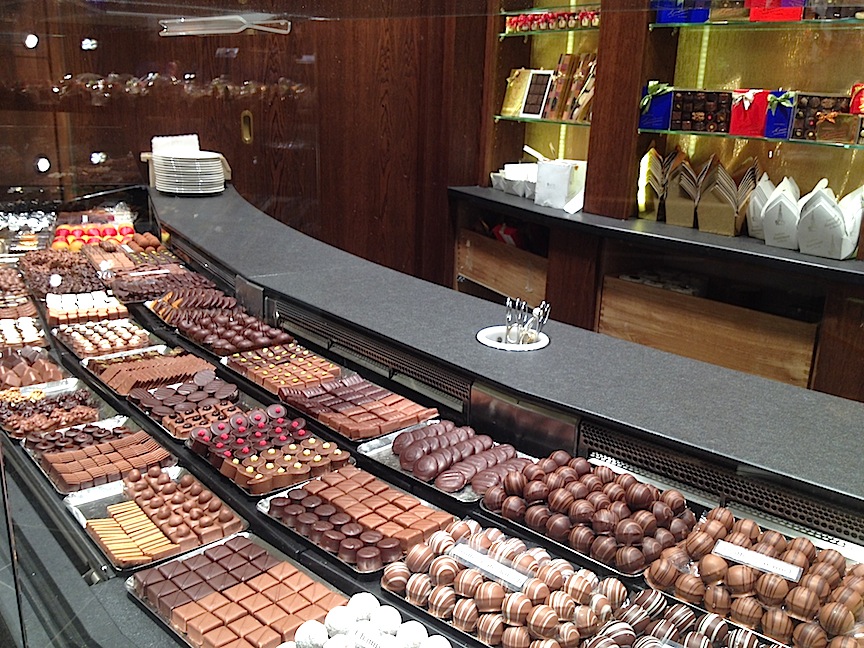 There also are official town guides
available through the Tourism Organization Engadin
St. Moritz if you want to delve deeper into the
history of this historic valley. Our affable
guide, Franz Balmer, led us on an excursion that
covered everything from an art installation, a tower
every bit as leaning as that of Pisa, a
hand-chiseled bobsled run, and much more. It also
included a visit to Glattfelder,
where visitors stock up on tea, coffee, caviar, and
more. If you have a sweet tooth, Hanselmann (right) is a
must-visit. Its pastries are gorgeous, and a hot
chocolate there is a pleasant way to warm up after a
day on the slopes.
There also are official town guides
available through the Tourism Organization Engadin
St. Moritz if you want to delve deeper into the
history of this historic valley. Our affable
guide, Franz Balmer, led us on an excursion that
covered everything from an art installation, a tower
every bit as leaning as that of Pisa, a
hand-chiseled bobsled run, and much more. It also
included a visit to Glattfelder,
where visitors stock up on tea, coffee, caviar, and
more. If you have a sweet tooth, Hanselmann (right) is a
must-visit. Its pastries are gorgeous, and a hot
chocolate there is a pleasant way to warm up after a
day on the slopes.
This part of Switzerland is
a terrific destination, even if you don’t ski or
bobsled, and enjoying it from a resort like
Badrutt’s Palace produces the feeling of being in an
almost dream-like idyll where Old World
sophistication, luxury, and friendliness coalesce in
snowy wonder.
❖❖❖
NEW
YORK CORNER
By John Mariani

405 E 52nd Street (near First Avenue)
212-755-6244
www.leperigord.com
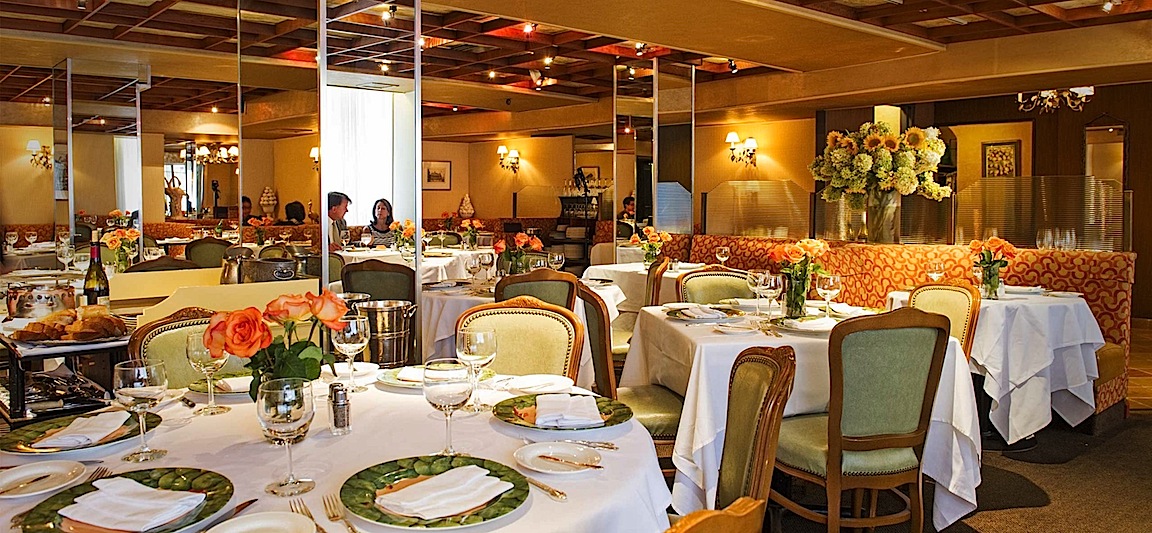
Those myopic
media who somehow take delight in declaring the end of
French haute cuisine in New York obviously have not
dined recently at Restaurant Daniel, Le Bernardin,
Jean-Georges, or La Grenouille, not to mention so many
more casual French restaurants around town doing
stellar French cuisine. Anyone craving the
cherished, proven classics of the genre need only book
a table at Le
Périgord which, under Georges Briguet and his
son Christopher, sails on, through culinary fashion,
drawing a faithful clientele who have become friends
of the family and could not imagine a world without
beloved dishes like Dover sole à la
meunière, quenelles of pike in sauce
Nantua, and oeufs
à la neige.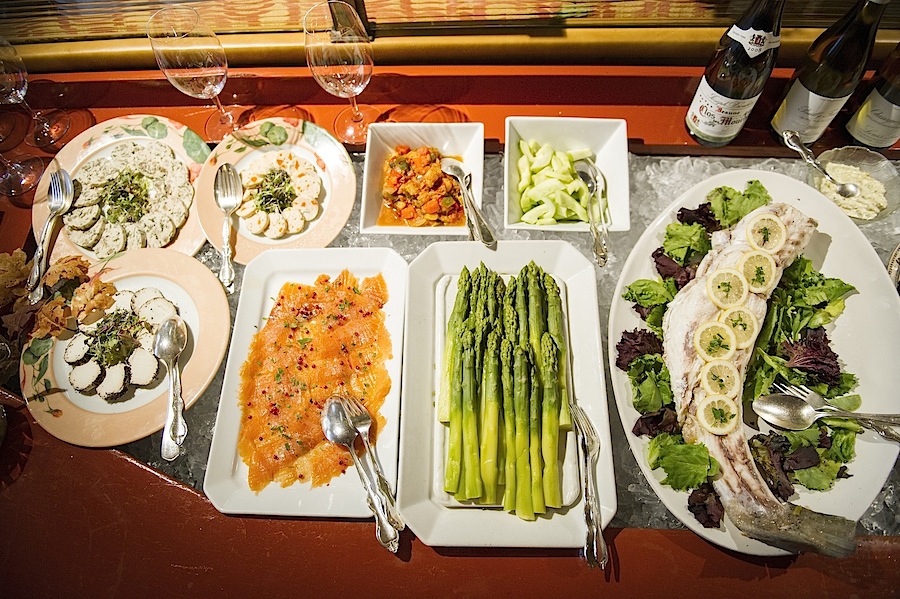
Located near Sutton Place and not
far from the United Nations, Le Périgord has
always been a draw for ambassadors on a culinary
mission, and the affable Messrs. Briguet and their
veteran service staff keep everything the way it has
been since the restaurant opened 50 years ago.
Chef Joel Benjamin has been in the kitchen for
several years now, so consistency is taken very
seriously, while new ideas adhere to the precision of
French classicism.
The
250-label wine list is remarkably well priced,
especially among older vintages of illustrious French
wines.
When you walk in,
the first thing you see is a buffet table laden with
cold appetizers, from smoked salmon and poached
asparagus to pâtés, terrines, and cold
shellfish with mayonnaise: a selection is $22 at
dinner. This is in addition to the menu starters,
which include a rich but light lobster bisque; one of
the best foie gras terrines with glistening Sauternes
gelée in the city; equally fine fresh foie gras
is quickly seared and served with seasonal fruits and
warm brioche; a salad of sweetbreads is spiced with
harissa and a pepper emulsion, which one evening
served to block the subtle flavor of the sweetbreads.
There are always specials at Le
Périgord; on one recent night there was superb
venison with a good gamey flavor and a wonderful sauce
reduction au Grand Véneur. If you
like--and miss--quenelles of pike in sauce Nantua, Le
Périgord still makes them on a regular basis
and they are puffy and delicious. Good,
old-fashioned duck à
l’orange, so often a pre-cooked, cloying
mess, is here done right--crisp, sizzling skin, and
tender, flavorful meat beneath a silken bittersweet
orange sauce, the bird itself carved tableside with a
dexterity Le Périgord’s captain and waiters
perfected long ago.
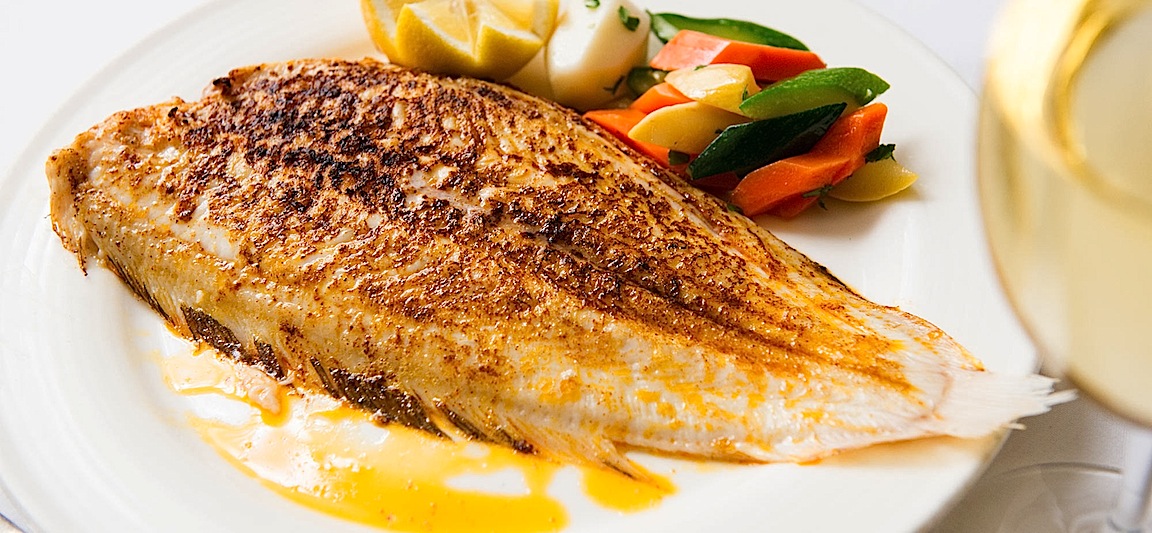 Dover
sole (left),
thankfully, has not receded in popularity in fine
restaurants around New York, and Le Périgord’s
is textbook perfect--fat, with firm texture, lightly
dusted with flour and sautéed in plenty of good
butter, so that the flesh comes cleanly away from the
bones. Another special one night at Le
Périgord was the rarely seen filet of beef
Wellington, which comes packed with truffles and foie
gras and is then wrapped in puff pastry with sauce Périgourdine
with a dice of black truffles. It’s a difficult
dish to pull off, because there is the prospect the
meat will steam rather than roast, and the pastry may
get soggy. The beef that night was well rendered but
the pastry was, indeed, soggy.
Dover
sole (left),
thankfully, has not receded in popularity in fine
restaurants around New York, and Le Périgord’s
is textbook perfect--fat, with firm texture, lightly
dusted with flour and sautéed in plenty of good
butter, so that the flesh comes cleanly away from the
bones. Another special one night at Le
Périgord was the rarely seen filet of beef
Wellington, which comes packed with truffles and foie
gras and is then wrapped in puff pastry with sauce Périgourdine
with a dice of black truffles. It’s a difficult
dish to pull off, because there is the prospect the
meat will steam rather than roast, and the pastry may
get soggy. The beef that night was well rendered but
the pastry was, indeed, soggy.
This being a proper French
restaurant, there is a fine selection of ripe cheeses,
but it is pretty difficult not to be swayed by the
panoply of desserts, which include one of my very
favorites, oeufs
à la neige, or floating island,
composed of meringue egg whites bobbing in a rich,
vanilla-flavored crème anglaise.
If you’ve longed for chocolate
mousse, here is where you’ll find a most splendid
example, and the pastries and fruit tarts are
exemplary, too. Ask for a little of this and a
dollop of that, and you will not be refused.
too. Ask for a little of this and a
dollop of that, and you will not be refused.
As remarkable as everything else
that Le Périgord does with such finesse is the
price of a meal here, which comes in considerably
below its competitors. A prix fixe lunch is just
$32 and dinner $68 (with à la carte options,
too).
The restaurant also
carries on the admirable tradition of being open on
Sundays for dinner, which gives it the familial
ambiance of those for whom it has become a ritual.
The Briguets try hard to provide that sense to
their clients, for this is a family-run restaurant
that takes pride in its longevity and in its
commitment to upholding standards of cuisine and
hospitality that are far from gone in New York and a
reminder of what civilized dining truly means.
Le Périgord is open Mon.-Fri. for
lunch and nightly for dinner.
❖❖❖
NOTES FROM THE
SPIRITS LOCKER
By John Mariani
IRISH
WHISKEY IS FIT FOR MORE THAN
A TOT OR TWO ON ST PADDY’S DAY
By John Mariani
 St. Patrick’s Day
should not be an excuse to knock back an Oy-rish
whiskey or to use it as an additive to hot coffee; it
should simply be another occasion to do so. And
with worldwide sales soaring in the red-hot spirits
market--right along with Single Malt Scotch, bourbon
and Asian whiskies--a lot of people apparently agree.
St. Patrick’s Day
should not be an excuse to knock back an Oy-rish
whiskey or to use it as an additive to hot coffee; it
should simply be another occasion to do so. And
with worldwide sales soaring in the red-hot spirits
market--right along with Single Malt Scotch, bourbon
and Asian whiskies--a lot of people apparently agree.
The Irish
themselves consume only about 6 million bottles, with
France the next largest consumer. According to
Bord Bia (Ireland’s Food Board), sales of Irish
whiskey in the U.S. topped $167 million over the past
two years, and, although Irish whiskey accounts for
just 5 percent of all whiskey sold in this country, it
makes up more than 13 percent of the revenue.
The
number of labels now in the market can be dizzying,
even though all Irish whiskey is made in just three
distilleries: Midleton (owned by Pernod-Ricard) in
Cork, Bushmills in Antrim, and Cooley in Louth (the
only one Irish-owned). A century ago there were 150
distilleries making 400 brands, but the industry was
crippled by the onset of Prohibition in the U.S. A big
boost came with the popularity of Irish
coffee--unknown in Ireland, or anywhere else, until
1942, when first created at the bar at Foynes Dock,
where flying boats docked during World War II. The hot
beverage was promoted as a welcoming drink at Shannon
Airport and debuted in the U.S. at the Buena Vista Bar
in San Francisco in 1952.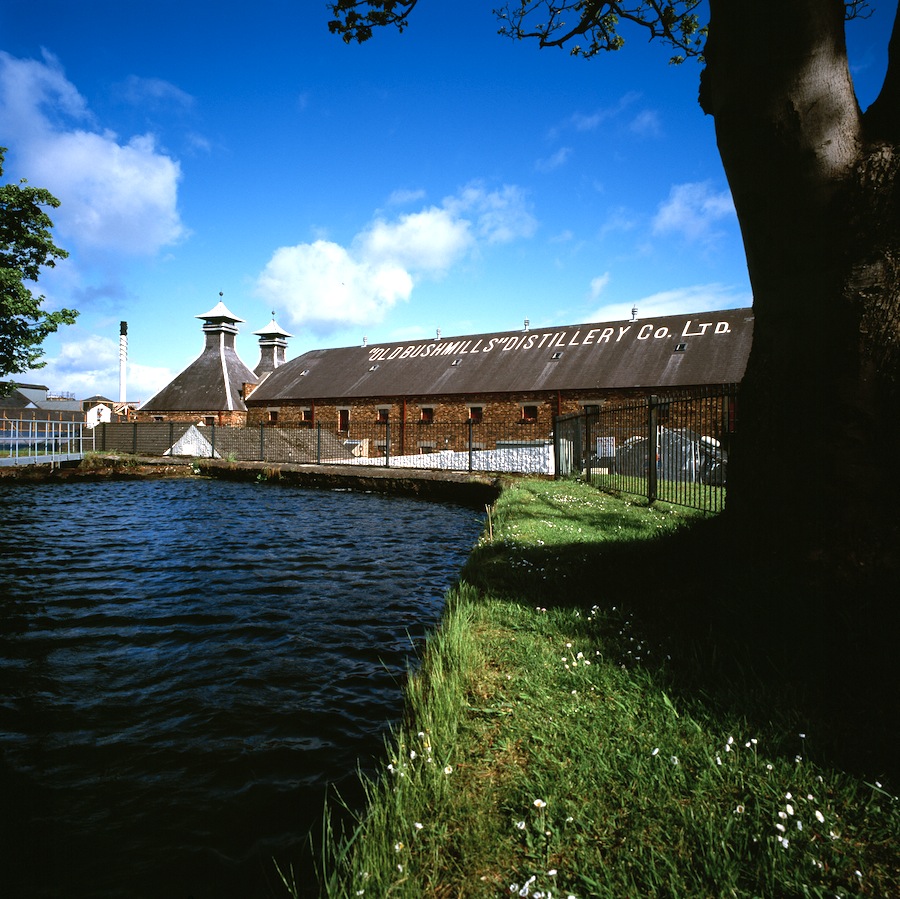
Today,
prestigious small-batch labels cost upwards of $200,
yet the average price for a bottle of Irish is still
below $25, making it far more affordable than Single
Malt Scotch. The key to marketing now is to
offer small supplies of special bottlings that have
varying degrees of depth, complexity, woodiness,
peatiness, and smokiness. Since most Irish
whiskies are blends, those with vintage dates on them
are often more novelty than innovation.
Tullamore
Dew makes a good basic label, a 12-Year-Old ($37);
Cooley’s Connemara brand alone now makes four small
batch whiskies--a 12-Year-Old Peated Single Malt
($100), a Single Cask ($47), a Cask Strength ($80),
and the heavily peated Turf Mor labels ($100-$150); a
16-year old Knappogue Castle 14-Year-Old "Twin Wood"
single malt ($100) caused some excitement when
released three years ago, with most sold in the U.S.;
Midleton Very Rare ($125) comes in an oak box labeled
as “Supreme Selection”; Redbreast 12 ($60) claims to
be the “only 100% pure pot still” example on the
market today.
But
the dominant brand over all others in Bushmills, which
at any given time may have half a dozen different
whiskies for sale, some destined for specific markets,
like Asia. It also has its own distillery.
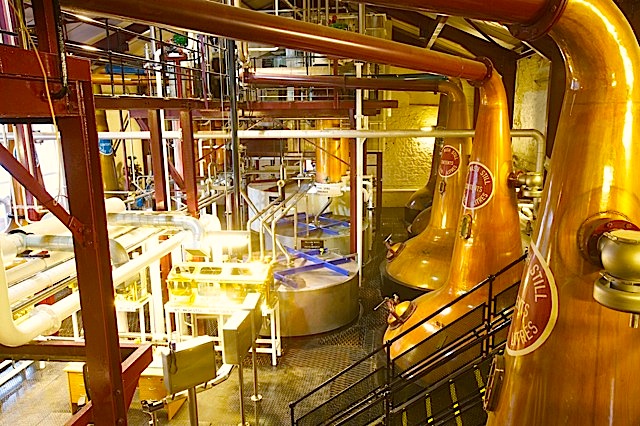 Bushmills' standard
“White Label” ($24) was once the favorite of
Czar Peter the Great. Its Black Bush ($30), aged
in old sherry casks, has long been a big seller in the
U.S., with a more pronounced maltiness and a near
Sherry-like, soft finish. Bushmills’ colored labels
have different flavor profiles and ages. Green
Label 10 Years, aged in bourbon barrels, has a
lighter, almost genteel virtue, very smooth, with a
honey finish and very little heat at the end.
(They also make a whiskey that actually contains
honey, but that’s a special taste, best as a mixer.)
Bushmills' standard
“White Label” ($24) was once the favorite of
Czar Peter the Great. Its Black Bush ($30), aged
in old sherry casks, has long been a big seller in the
U.S., with a more pronounced maltiness and a near
Sherry-like, soft finish. Bushmills’ colored labels
have different flavor profiles and ages. Green
Label 10 Years, aged in bourbon barrels, has a
lighter, almost genteel virtue, very smooth, with a
honey finish and very little heat at the end.
(They also make a whiskey that actually contains
honey, but that’s a special taste, best as a mixer.)
Their 10-Year-Old
Single Malt ($40) competes easily with fine Scotch
Single Malts. Made from 100% malted barley, distilled
three times, and matured in bourbon barrels for at
least 10 years, this has a lively smokiness in the
bouquet, with level after level of complex spices and
fruit, finishing like velvet on the back of the
throat. The 16-Year-Old ($75) is a brawnier
whiskey, quite nutty, with a dark chocolate and dried
fruit component. The 21-Year Old ($125) is aged for 19
years in oloroso sherry casks, then in bourbon casks,
then in Madeira casks--all imparting nuances to the
boldness of the end result. There is also a good
deal of maltiness in this bottle and an expression of
how and why Irish whiskey is not for an idle tot or
celebratory swig. It is for pure, slow enjoyment.
LOVE IN A BOTTLE
 by Cristina Mariani-May
by Cristina Mariani-May
co-CEO of Banfi Vintners America's leading wine importer
Ah, Verona! – the
quintessential city of love, immortalized by the Bard’s
tale of "Romeo and Juliet." But if you’ve been
to Verona, you know that this town is far too
romantic to boast just one love story.
Take, for example, a favorite of wine lovers, the
story of Regolo and Ferdinanda Sartori (below).
He was a former World War I pilot who convinced his
father to shift the family business from a
restaurant that made its own wine to a full-fledged
winery. She was considered to be the only woman who
could ever stand up to and tame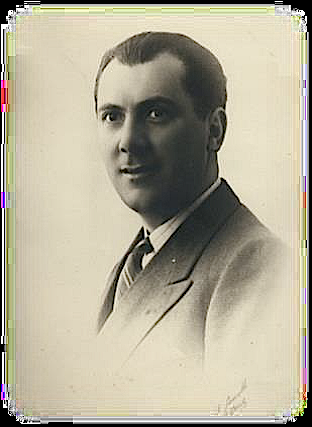 his
adventurous nature.
his
adventurous nature.
Known for his exceptional palate and deft hand at
winemaking, Regolo custom tailored (after all,
Sartori is derived from the Italian word for tailor)
his blends for his clientele and built a reputation
that saw the winery grow in those challenging years
following World War II. Ferdinanda, or Ferdi
as she was called, ran the household of their Villa
Maria and looked after their two young sons.
She even fished the local pond to source the
freshest dinner!
Then tragedy struck; Regolo died, far too
young. His father came out of retirement, but
only grudgingly so because of advanced age. It
was really up to Ferdinanda and her sons to keep the
company going. She encouraged them, trained
them, protected them, and pushed them. Of two
 very different characters,
they made ideal business partners – the elder and
more serious Franco was dubbed “Minister of the
Interior” for his skill at running the day-to-day
affairs of the business, while his younger, more
gregarious and outgoing brother Pierumberto became
the company’s “Foreign Minister,” opening new
markets and charming new customers. But firmly
behind them in their formative years was the “Prime
Minister” herself, Ferdinanda, a force to be
reckoned with.
very different characters,
they made ideal business partners – the elder and
more serious Franco was dubbed “Minister of the
Interior” for his skill at running the day-to-day
affairs of the business, while his younger, more
gregarious and outgoing brother Pierumberto became
the company’s “Foreign Minister,” opening new
markets and charming new customers. But firmly
behind them in their formative years was the “Prime
Minister” herself, Ferdinanda, a force to be
reckoned with.
Today the Sartori family is in its fourth
generation, led by Andrea Sartori who does his
grandparents proud. He smartly runs a thriving
business and deftly manages its impeccable
reputation, thanks to the values handed down by
Regolo and fostered by Ferdinanda. In fact,
"G4," as he's nicknamed, has honored this
incredible couple with a pair of wines reflecting
their unique character and distinct nature.
Regolo is a special selection
of indigenous local Corvina grapes; after
fermentation the wine rests on the crushed grapes of
the winery’s Amarone to add additional complexity
and ageability. The wine is aged for about two
years in medium to large barrels and further aged in
the winery before release; it is a deep and complex
wine, with aromas of woodland berries and hints of
cherry and ripe fruit on the palate. It can be
found on wine lists for under $60, making it a great
value for a big wine.
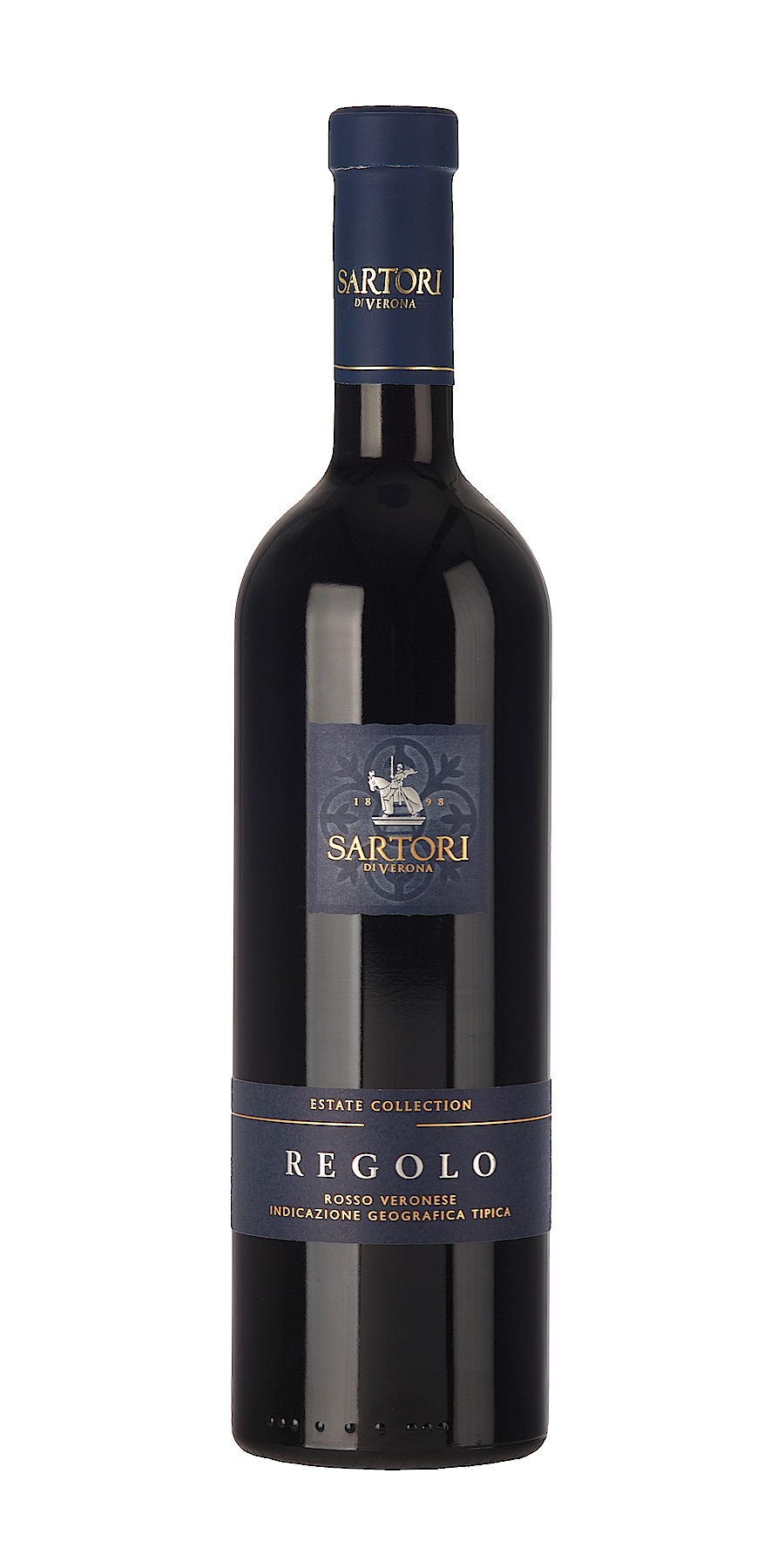 Ferdi is also a unique wine with
plenty of character to live up to its
namesake. Garganega grapes, indigenous to the
area and the main component of Soave, are
hand-picked and left to dry on racks using the same
technique as the grapes for the red Amarone
(only for a shorter period– 40 days instead of
90 for Amarone), to reduce water and concentrate
sugar content and color. The grapes are
pressed with a brief fermentation on the
skins. The wine has gorgeous aromas of pears
and apricots, with subtle floral taste. Rich
and dry on the palate, it has an unusually long
finish for a white wine. You could easily find
this wine offered by the glass at great restaurants
for around $12, and on the list under $50. And
just as Ferdinanda could stand up to her husband and
father-in-law, Ferdi the wine can even hold its own
and demonstrate its great complexity after a tasting
of Amarones or a meal of rich foods. Just like
a great lady.
Ferdi is also a unique wine with
plenty of character to live up to its
namesake. Garganega grapes, indigenous to the
area and the main component of Soave, are
hand-picked and left to dry on racks using the same
technique as the grapes for the red Amarone
(only for a shorter period– 40 days instead of
90 for Amarone), to reduce water and concentrate
sugar content and color. The grapes are
pressed with a brief fermentation on the
skins. The wine has gorgeous aromas of pears
and apricots, with subtle floral taste. Rich
and dry on the palate, it has an unusually long
finish for a white wine. You could easily find
this wine offered by the glass at great restaurants
for around $12, and on the list under $50. And
just as Ferdinanda could stand up to her husband and
father-in-law, Ferdi the wine can even hold its own
and demonstrate its great complexity after a tasting
of Amarones or a meal of rich foods. Just like
a great lady.
Cristina Mariani is not related by family or
through business with John Mariani, publisher of
this newsletter
 "He was like
this bearded dude wearing like
"He was like
this bearded dude wearing like
this long
sheet and gnarly sandals. . . ."
After receiving a tip at much as $7,000 tip by TipsForJesus, waiter Ron Kinney of the French Quarter restaurant in Los Angeles tossed the receipt away, believing it was from "someone who had a drink too many and didn't realize what they were doing." After learning of his mistake he was unable to locate the missing receipt.

NEVER FINISHED READING
"Savor,
the new restaurant in Klyde Warren Park, reminds me
of
the Affordable Care Act."--Leslie Brenner, "Savor,"
Dallas Morning News.
❖❖❖
 ANNOUNCEMENT: The 10th annual Savor Dallas,
March 20-22, 2014, celebrates wine, food, spirits and
the arts in downtown Dallas and nearby locations.
"Savor the Arboretum"at the Dallas Arboretum and
Botanical Garden kicks off the festivities with wine
and chef cuisine in the gardens on Thurs., followed by
the popular "Arts District Wine Stroll" on Fri.
Sat. features include a Winemaker Tasting Panel,
a modern mixology seminar, The Reserve Tasting, and
"The International Grand Tasting" offering
cuisine from dozens of the area’s top chefs and more
than 400 premium wines, spirits and craft beers.
Prices for individual events range from $20 to
$150…$365 for a cost-saving weekend package. For tickets
and more information visit www.SavorDallas.com or call 888-728-6747.
ANNOUNCEMENT: The 10th annual Savor Dallas,
March 20-22, 2014, celebrates wine, food, spirits and
the arts in downtown Dallas and nearby locations.
"Savor the Arboretum"at the Dallas Arboretum and
Botanical Garden kicks off the festivities with wine
and chef cuisine in the gardens on Thurs., followed by
the popular "Arts District Wine Stroll" on Fri.
Sat. features include a Winemaker Tasting Panel,
a modern mixology seminar, The Reserve Tasting, and
"The International Grand Tasting" offering
cuisine from dozens of the area’s top chefs and more
than 400 premium wines, spirits and craft beers.
Prices for individual events range from $20 to
$150…$365 for a cost-saving weekend package. For tickets
and more information visit www.SavorDallas.com or call 888-728-6747.
❖❖❖
Any of John Mariani's
books below may be ordered from amazon.com.
 |
The Encyclopedia of American Food
and Drink by John F. Mariani
(Bloomsbury USA, $35) Modesty forbids me to praise my own new book, but let me proudly say that it is an extensive revision of the 4th edition that appeared more than a decade ago, before locavores, molecular cuisine, modernist cuisine, the Food Network and so much more, now included. Word origins have been completely updated, as have per capita consumption and production stats. Most important, for the first time since publication in the 1980s, the book includes more than 100 biographies of Americans who have changed the way we cook, eat and drink -- from Fannie Farmer and Julia Child to Robert Mondavi and Thomas Keller. "This book is amazing! It has entries for everything from `abalone' to `zwieback,' plus more than 500 recipes for classic American dishes and drinks."--Devra First, The Boston Globe. "Much needed in any kitchen library."--Bon Appetit. |
"Eating Italian will never be the same after reading John Mariani's entertaining and savory gastronomical history of the cuisine of Italy and how it won over appetites worldwide. . . . This book is such a tasteful narrative that it will literally make you hungry for Italian food and arouse your appetite for gastronomical history."--Don Oldenburg, USA Today. "Italian
restaurants--some good, some glitzy--far
outnumber their French rivals. Many of
these establishments are zestfully described
in How Italian Food Conquered the World, an
entertaining and fact-filled chronicle by
food-and-wine correspondent John F.
Mariani."--Aram Bakshian Jr., Wall Street
Journal.
"Equal parts
history, sociology, gastronomy, and just
plain fun, How Italian Food Conquered the
World tells the captivating and delicious
story of the (let's face it) everybody's
favorite cuisine with clarity, verve and
more than one surprise."--Colman Andrews,
editorial director of The Daily
Meal.com. "A fantastic and fascinating
read, covering everything from the influence
of Venice's spice trade to the impact of
Italian immigrants in America and the
evolution of alta cucina. This book will
serve as a terrific resource to anyone
interested in the real story of Italian
food."--Mary Ann Esposito, host of PBS-TV's
Ciao
Italia. "John Mariani has written the
definitive history of how Italians won their
way into our hearts, minds, and
stomachs. It's a story of pleasure over
pomp and taste over technique."--Danny Meyer,
owner of NYC restaurants Union Square
Cafe, The Modern, and Maialino.
|
 |
 |
 |
 |
 |
 |
 |
 |
 Everett Potter's Travel Report:
Everett Potter's Travel Report: 
 Eating Las Vegas
is the new on-line site for Virtual Gourmet
contributor John A. Curtas., who since 1995
has been commenting on the Las Vegas food
scene and reviewing restaurants for Nevada
Public Radio. He is also the
restaurant critic for KLAS TV, Channel 8 in
Las Vegas, and his past reviews can be
accessed at KNPR.org.
Click on the logo below to go directly to
his site.
Eating Las Vegas
is the new on-line site for Virtual Gourmet
contributor John A. Curtas., who since 1995
has been commenting on the Las Vegas food
scene and reviewing restaurants for Nevada
Public Radio. He is also the
restaurant critic for KLAS TV, Channel 8 in
Las Vegas, and his past reviews can be
accessed at KNPR.org.
Click on the logo below to go directly to
his site.

Tennis Resorts Online: A Critical Guide to the World's Best Tennis Resorts and Tennis Camps, published by ROGER COX, who has spent more than two decades writing about tennis travel, including a 17-year stretch for Tennis magazine. He has also written for Arthur Frommer's Budget Travel, New York Magazine, Travel & Leisure, Esquire, Money, USTA Magazine, Men's Journal, and The Robb Report. He has authored two books-The World's Best Tennis Vacations (Stephen Greene Press/Viking Penguin, 1990) and The Best Places to Stay in the Rockies (Houghton Mifflin, 1992 & 1994), and the Melbourne (Australia) chapter to the Wall Street Journal Business Guide to Cities of the Pacific Rim (Fodor's Travel Guides, 1991).


MARIANI'S VIRTUAL GOURMET
NEWSLETTER is published weekly. Editor/Publisher: John
Mariani. Contributing Writers: Christopher Mariani,
Robert Mariani, John A.
Curtas, Edward Brivio, Mort Hochstein, Suzanne
Wright, and Brian Freedman. Contributing
Photographers: Galina Stepanoff-Dargery,
Bobby Pirillo. Technical Advisor: Gerry McLoughlin.
© copyright John Mariani 2014
